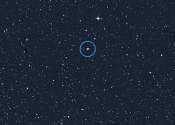Stars need a partner to spin universe's brightest explosions
When it comes to the biggest and brightest explosions seen in the Universe, University of Warwick astronomers have found that it takes two stars to make a gamma-ray burst.

When it comes to the biggest and brightest explosions seen in the Universe, University of Warwick astronomers have found that it takes two stars to make a gamma-ray burst.
Astronomy
Jan 13, 2020
0
203

Astronomers using data from NASA's Transiting Exoplanet Survey Satellite (TESS) have shown that Alpha Draconis, a well-studied star visible to the naked eye, and its fainter companion star regularly eclipse each other. While ...
Astronomy
Jan 7, 2020
0
221

Twin stars appear to share chemical "DNA" that could help scientists map the history of the Milky Way galaxy, according to new research by astronomer Keith Hawkins of The University of Texas at Austin accepted for publication ...
Astronomy
Dec 23, 2019
0
65

Scientists using the MeerKAT radio telescope have discovered a unique and previously-unseen flare of radio emission from a binary star in our galaxy.
Astronomy
Nov 20, 2019
0
233

In an unprecedented feat, an American research team discovered hidden secrets of an elusive exoplanet using a powerful new instrument at the 8-meter Gemini North telescope on Maunakea in Hawai'i. The findings not only classify ...
Astronomy
Aug 30, 2019
0
1059

Gravitational wave researchers at the University of Birmingham have developed a new model that could help astronomers track down the origin of heavy black hole systems in the Universe.
Astronomy
Aug 8, 2019
3
641

Scientists can tell a lot about a star by the light it gives off. The color, for example, reveals its surface temperature and the elements in and around it. Brightness correlates with a star's mass, and for many stars, brightness ...
Astronomy
Aug 2, 2019
7
1107

A team of researchers from the U.S., Denmark and the U.K., working with a group at NASA's Ames Research Center, has found a binary star system that dims unpredictably. They have written a paper describing their findings and ...

Scientists have found evidence that pairs of stars have been kicked out of their host galaxies. This discovery, made using data from NASA's Chandra X-ray Observatory, is one of the clearest examples of stellar pairs being ...
Astronomy
May 28, 2019
4
515

The sparsely distributed hot gas that exists in the space between galaxies, the intergalactic medium, is ionized. The question is, how? Astronomers know that once the early universe expanded and cooled enough, hydrogen (its ...
Astronomy
Mar 25, 2019
93
393